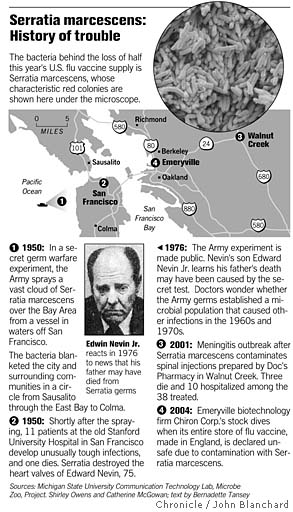|
Serratia in
the News
In 1819, Bartolomeo Bizio, a pharmacist from Padua,
Italy, discovered and named Serratia marcescens when he
identified the bacterium as the cause of a miraculous bloody discoloration
in a cornmeal mush called polenta. Bizio named Serratia
in honor of an Italian physicist named Serrati, who invented the
steamboat, and marcescens from the Latin word for decaying.
When the bacterium is grown at room temperature (25°C), it
produces a red pigment called prodigiosin. Prodigiosin has antimicrobial
properties.
Until the 1960s, S. marcescens was considered harmless.
In fact, the military secretly dispersed it across U.S. cities to
determine how biological weapons would spread. In 1950, Navy vessels
cruised the San Francisco coast, spewing huge amounts of the bacterium
into the air over the City. At least one hospital noticed an increase
in pneumonia patients. In the 1970s, when the military disclosed
the tests, a San Francisco family sued over a pneumonia death they
blamed on Serratia.
Serratia has contaminated medical products causing recalls
a heparin- and saline-filled syringes (2007) and an
influenza vaccine (2004).
|
From Reuters
March 30, 2011
Nine patients in Alabama died from Serratia infections
after receiving total parenternal (intravenous) nutrition
(TPM). Alabama Department of Health says they now know the
point at which the Serratia marcescens contamination
occurred.
The outbreak which affected 19 patients in six Alabama hospitals,
was linked to TPN supplied by Meds IV Pharmacy in Birmingham.
A failure in the sterilization step of the process allowed
the bacteria to pass through the rest of production and get
into the final product TPN. |
| From the Contra Costa Times
July 5, 2001
State officials said Tuesday they will seek to shut down
a Walnut Creek pharmacy that allegedly was the source of a
batch of bacteria-tainted medication linked to an outbreak
of illnesses and three meningitis deaths.
A petition filed by the state Attorney General's Office asserts
that inadequate sterilization measures and improper use of
key equipment contributed to the contamination of a 300 milliliter
batch of injectable steroid when it was mixed at Doc's Pharmacy
on May 11.
As many as 38 people received injections from the batch at
two Contra Costa outpatient clinics. Thirteen people who received
injections at the Sierra SurgiCenter in Walnut Creek were
later hospitalized; of those 13, five contracted meningitis
and three died.
Sealed vials seized from the center and two other outpatient
clinics in Contra Costa were later found to contain the serratia
marcescens bacteria linked to the outbreak. |
Under what conditions is the red pigment, prodigiosin, made?
|

Serratia marcescens growing on nutrient agar.
Photo©CLCase

|

